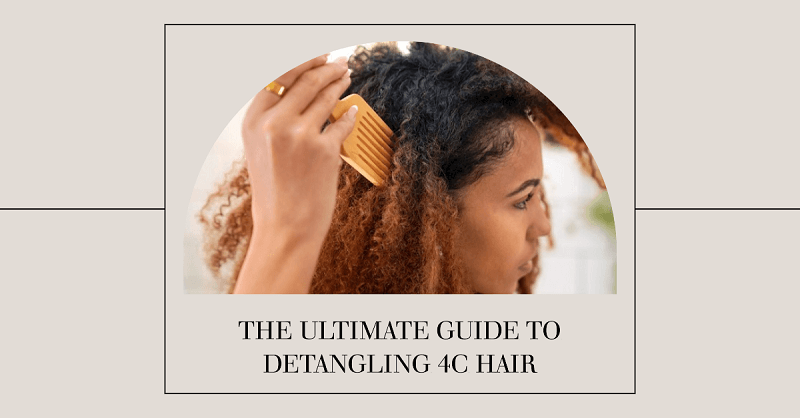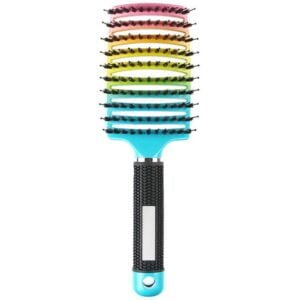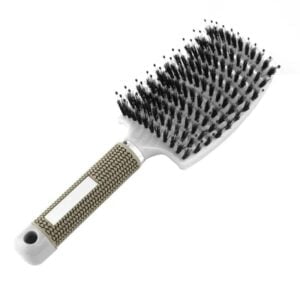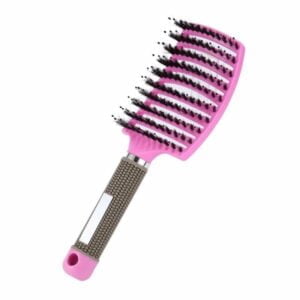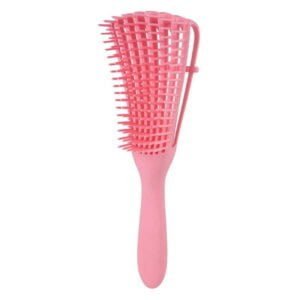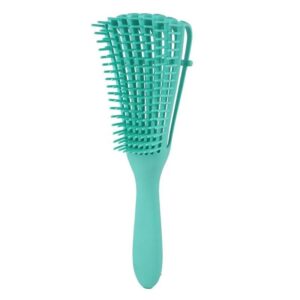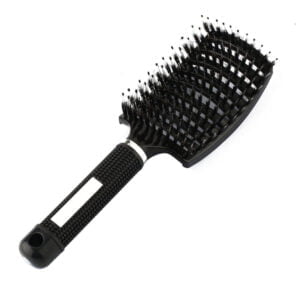Introduction
Welcome to our comprehensive guide on detangling 4C hair! If you’re a parent or caregiver looking for the best way to keep your little one’s hair tangle-free and gorgeous, you’ve come to the right place. Healthy and well-groomed hair plays a vital role in boosting a child’s confidence and self-esteem. In this article, we’ll provide you with expert advice, address common concerns, and introduce you to the top hair brushes designed specifically for tackling knots and tangles in 4C hair. Get ready to revolutionize your haircare routine and achieve tangle-free, healthy, and beautiful hair for your child.
On This Page
Understanding 4C Hair
Before diving into the world of detangling brushes, let’s first understand the unique characteristics of 4C hair. 4C hair is known for its tight curls, coil patterns, and delicate texture. It is commonly found in individuals of African descent, but it can vary in thickness and density from person to person. Due to the tightly coiled structure, 4C hair is prone to tangling and can require special care and attention during the detangling process. Understanding the challenges associated with 4C hair will help you make informed choices when selecting the right tools and techniques for detangling.
Detangling 4C hair requires a combination of patience, proper technique, and suitable haircare practices. Many parents wonder if it’s possible to detangle 4C hair with a brush without causing damage or pain. The answer is yes! However, it’s crucial to choose the right brush that suits the unique needs of 4C hair. The right brush will detangle the hair gently, minimizing breakage and making the process easier for both you and your child.
In the following sections, we’ll explore the best detangling brushes for 4C hair, provide step-by-step instructions on how to detangle effectively, and offer valuable tips to make the process smoother and more enjoyable. With the right knowledge and tools at your disposal, you’ll be well-equipped to handle any knots and tangles that come your way. So, let’s dive in and discover the world of hair brushes specifically designed for 4C hair!

Can You Detangle 4C Hair with a Brush?
One of the common concerns among parents and caregivers is whether it’s possible to effectively detangle 4C hair using a brush. The good news is that you can detangle 4C hair with a brush, but it’s essential to choose the right brush to ensure a safe and successful detangling experience.
When selecting a brush for detangling 4C hair, look for brushes specifically designed for curly and coily hair types. These brushes typically have features that make them more suitable for detangling, such as wide-toothed designs, flexible bristles, and gentle detangling technology. Avoid brushes with tightly packed bristles or sharp, pointy tips, as they can cause breakage and discomfort.
It’s important to approach detangling with patience and care. Start by sectioning the hair into smaller portions to make the process more manageable. Begin detangling from the ends of the hair and work your way up to the roots, using gentle, downward strokes. This helps to gradually release the knots and tangles without causing unnecessary pulling or breakage.
Remember, everyone’s hair is unique, so it’s important to pay attention to your child’s specific hair needs. If you notice that a particular brush or technique is causing discomfort or excessive hair breakage, don’t hesitate to try alternative options until you find what works best for your child’s 4C hair.
5 Steps on How to Detangle 4B and 4C Hair
Detangling 4B and 4C hair requires a thoughtful approach and the use of proper techniques to minimize breakage and maintain hair health. Whether you choose to detangle the hair wet or dry depends on personal preference and the specific needs of your child’s hair. Let’s explore some step-by-step instructions and techniques for detangling 4B and 4C hair effectively:
Start with Preparations
Before detangling, it’s important to prepare the hair by applying a moisturizing conditioner or detangling spray. This helps to soften the hair and make it more manageable. Divide the hair into smaller sections to make the detangling process easier and more efficient.
Finger Detangling
Begin by using your fingers to gently separate the strands and work through any large knots or tangles. Finger detangling allows you to have more control and feel for the hair, reducing the risk of excessive pulling or breakage.
Wide-Tooth Comb
Once you’ve finger-detangled as much as possible, you can use a wide-tooth comb to further detangle the hair. Start combing from the ends, gradually working your way up to the roots. Be gentle and patient, and if you encounter stubborn knots, use your fingers or a detangling brush to help loosen them.
Detangling Brush
A detangling brush specifically designed for 4B and 4C hair can be a valuable tool in your detangling arsenal. Look for a brush with wide-spaced, flexible bristles that glide through the hair without causing excessive pulling or breakage. Use the brush in combination with your fingers or wide-tooth comb for the best results.
Detangling Wet or Dry
Some individuals prefer to detangle their 4B and 4C hair while it’s wet, as it can be easier to work through tangles. However, others find that detangling dry hair minimizes shrinkage and allows for better control. Experiment with both methods to determine which works best for your child’s hair and personal preference.
Remember, the key to successful detangling is patience and gentleness. Take your time, work in small sections, and always listen to your child’s cues. If you encounter excessive resistance or discomfort, stop and re-evaluate your approach. With practice and the right techniques, you’ll become adept at detangling 4B and 4C hair, ensuring a smooth and pain-free experience for both you and your child.
In the next section, we’ll explore the best detangling brushes specifically designed for 4C hair. These brushes are equipped with features that make them particularly effective in tackling knots and tangles. Let’s find the perfect brush to make your detangling routine a breeze!

5 Best Detangling Brushes for 4C Hair
When it comes to detangling 4C hair, using the right brush can make a world of difference. Here, we’ll introduce you to some of the best detangling brushes specifically designed to tackle knots and tangles in 4C hair. These brushes have features that promote gentle detangling, minimize breakage, and make the process more manageable. Let’s explore the top picks for detangling brushes:
Gentle Hair Brush
Look for a brush with flexible bristles and a wide-toothed design. These brushes gently glide through 4C hair, detangling knots without causing excessive pulling or breakage. Opt for brushes made from materials such as silicone or nylon, as they provide gentle stimulation to the scalp while detangling.
Wide-Toothed Comb
Although not technically a brush, a wide-toothed comb is an essential tool for detangling 4C hair. It helps to separate the strands and work through knots without causing damage. Choose a comb with wide-spaced teeth to minimize friction and breakage.
Detangling Brush with Flexible Bristles
Specifically designed for detangling curly and coily hair, these brushes feature flexible bristles that bend and flex as they move through the hair. They are excellent for gently removing tangles without causing discomfort or breakage.
Paddle Brush with Air Cushion
Paddle brushes with air cushion technology provide a gentle detangling experience. The cushioned base helps to distribute pressure evenly, reducing stress on the hair strands. Look for brushes with wide, flat bristle designs that can easily glide through 4C hair.
Brush with Detangling Technology
Some brushes incorporate innovative detangling technology, such as varying bristle lengths or special patterns. These features aid in unravelling knots and tangles without causing damage. Consider brushes with unique bristle configurations designed specifically for 4C hair.
Remember to choose a brush that suits your child’s hair texture, thickness, and sensitivity. It’s important to test different brushes and find the one that works best for your child’s hair needs. Additionally, always detangle with care, starting from the ends and working your way up to minimize breakage.
In the next section, we’ll provide techniques and tips for effective detangling of 4B and 4C hair, ensuring a smoother and more enjoyable experience for both you and your child.
8 Tips for Effective Detangling
Detangling 4B and 4C hair can be a challenging task, but with the right techniques and practices, you can make the process more manageable and minimize hair breakage. Here are some tips to help you detangle 4B and 4C hair effectively:
- Regular Detangling: Establish a regular detangling routine to prevent knots and tangles from becoming severe. How often you detangle will depend on your child’s hair needs and their daily activities. Aim to detangle at least once a week, but if your child’s hair is prone to tangling, you may need to detangle more frequently.
- Pre-Detangling Preparations: Before you begin detangling, apply a moisturizing conditioner or detangling spray to soften the hair and make it more pliable. This helps to reduce friction and breakage during the detangling process. Allow the product to sit on the hair for a few minutes before starting.
- Section the Hair: Divide the hair into smaller sections using clips or hairbands. This makes the detangling process more manageable, especially if your child has thick or long hair. Detangle one section at a time, starting from the ends and gradually working your way up to the roots.
- Use Fingers First: Begin the detangling process by using your fingers to gently separate the strands and work through any large knots or tangles. This helps to minimize breakage and allows you to have better control and feel for the hair.
- Detangle with a Wide-Tooth Comb or Detangling Brush: Once you’ve finger-detangled as much as possible, use a wide-tooth comb or detangling brush to further detangle the hair. Start from the ends and work your way up, using gentle, downward strokes. Be patient and take your time to release any remaining knots or tangles.
- Work in Small Sections: Work on small sections of hair at a time, rather than trying to detangle the entire head all at once. This prevents the hair from becoming overwhelming and ensures thorough detangling without causing unnecessary stress or breakage.
- Detangle Wet or Dry: Experiment with detangling on wet or dry hair to find what works best for your child’s hair. Some individuals find that detangling on wet hair with the aid of conditioner provides more slip and reduces breakage, while others prefer detangling on dry hair to minimize shrinkage. Listen to your child’s hair and adjust your approach accordingly.
- Be Gentle and Patient: Detangling 4B and 4C hair requires patience and gentleness. Avoid forcefully pulling or tugging at the hair, as this can lead to breakage. Take breaks if needed and always prioritize the comfort and well-being of your child during the detangling process.
By following these tips and techniques, you can detangle 4B and 4C hair more effectively, making it a more pleasant experience for both you and your child. In the next section, we’ll address common concerns and questions related to detangling 4C hair, providing you with valuable insights and answers.
Addressing Common Concerns and Questions About Detangling 4C Hair
Detangling 4C hair comes with its fair share of challenges, and it’s important to address common concerns and questions to ensure a successful haircare routine. Here, we’ll answer some frequently asked questions and provide valuable insights:
Why is 4C hair so hard to detangle?
4C hair has a tight curl pattern and tends to shrink, making it more prone to tangling. Additionally, the hair strands can be fragile, leading to breakage if not handled with care.
Should 4C hair be detangled wet or dry?
This can vary depending on personal preference. Some individuals find it easier to detangle 4C hair when wet as it provides more slip and reduces breakage. Others prefer detangling on dry hair to minimize shrinkage. Experiment with both methods and see what works best for your child’s hair.
How often should I detangle my 4C hair?
It’s recommended to detangle 4C hair at least once a week, but if your child’s hair is prone to tangling, you may need to detangle more frequently. Pay attention to your child’s hair needs and adjust accordingly.
Is a Tangle Teezer good for 4C hair?
Tangle Teezers are popular for their detangling abilities. However, they may not be the best choice for 4C hair as their bristles are closely spaced, which can potentially cause breakage. Opt for brushes with wider-spaced bristles that are more suitable for 4C hair.
Should you detangle 4C hair before washing?
Detangling before washing can help prevent the hair from matting and tangling further during the washing process. It’s generally recommended to detangle 4C hair before washing, using a wide-tooth comb or detangling brush.
Does detangling 4C hair help it grow?
Detangling 4C hair helps to maintain hair health by reducing breakage and preventing matting. Healthy hair is more likely to grow longer over time, so proper detangling practices contribute to overall hair growth.
Can I finger detangle instead of combing?
Finger detangling is a gentle and effective method for detangling 4C hair. It allows you to have better control and reduces the risk of breakage. Combine finger detangling with a wide-tooth comb or detangling brush for thorough detangling.
How do you soften matted 4C hair?
Matted hair can be challenging to deal with. To soften matted 4C hair, apply a moisturizing conditioner or detangling spray and gently work through the tangles using your fingers or a wide-tooth comb. Take your time and be patient to avoid excessive pulling or breakage.
Do detangling brushes really work?
Yes, detangling brushes designed specifically for 4C hair can be highly effective in removing knots and tangles. Look for brushes with features like flexible bristles, wide-tooth designs, and detangling technology for optimal results.
Is a detangling brush better than a comb?
Both detangling brushes and wide-tooth combs have their advantages. Brushes with flexible bristles can provide more slip, while wide-tooth combs are excellent for separating strands. The choice depends on personal preference and what works best for your child’s hair.
With these answers to common concerns and questions, you’re now equipped with the knowledge and tools necessary to navigate the world of detangling 4C hair. Remember, patience, gentleness, and choosing the right products and tools are key to a successful detangling experience. Embrace the journey of caring for your child’s hair, and let their beautiful curls and coils shine!
Alternatives to Brush Detangling
Exploring the option of finger detangling for 4C hair
When it comes to detangling 4C hair, one alternative to using a brush is finger detangling. Finger detangling involves using your fingers to work through knots and tangles, providing a gentler approach to haircare. Let’s explore the benefits and techniques of finger detangling for 4C hair.
Benefits and techniques of finger detangling
Finger detangling offers several benefits for 4C hair. Firstly, it allows you to have better control and feel for the hair, enabling you to identify and address tangles more precisely. It also reduces the risk of excessive pulling or breakage, as you can apply just the right amount of pressure needed to release the knots. Additionally, finger detangling promotes a closer connection with your child’s hair, fostering a sense of intimacy and care during the detangling process.
To effectively finger detangle 4C hair, start by applying a moisturizing conditioner or detangling spray to soften the hair and provide slip. Divide the hair into manageable sections and use your fingers to gently separate the strands, starting from the ends and working your way up to the roots. Carefully feel for any knots or tangles, and use your fingers to gently unravel them. Take your time, be patient, and work through the hair in small sections until it’s fully detangled.
Comparing the pros and cons of brush and finger detangling
Both brush and finger detangling have their pros and cons. Let’s compare them to help you make an informed decision based on your child’s hair needs and preferences.
Brush Detangling:
| Pros | Cons |
| 1. Can be faster and more efficient, especially with brushes designed specifically for 4C hair. 2. Provides a thorough detangling experience, especially for dense or tightly coiled hair. 3. Brushes with innovative features can minimize breakage and provide added benefits like scalp massage or anti-frizz properties. | 1. May cause discomfort or pain if not used gently, leading to breakage. 2. Not suitable for all hair types and textures. 3. Some brushes may have bristles too closely spaced, increasing the risk of snagging or damage. |
Finger Detangling:
| Pros | Cons |
| 1. Provides better control and minimizes the risk of excessive pulling or breakage. 2. Promotes a closer connection with your child’s hair and allows you to feel for knots and tangles more precisely. 3. Can be a gentle and intimate experience, fostering a positive relationship with haircare. | 1. Requires more time and patience compared to brush detangling. 2. May not be as efficient for dense or severely tangled hair. 3. Can be challenging to fully detangle small or hard-to-reach sections without the aid of a comb or brush. |
Ultimately, the choice between brush and finger detangling depends on your child’s hair texture, thickness, and personal preference. You can also combine both methods, starting with finger detangling to address major knots and tangles and then using a wide-tooth comb or detangling brush for further detangling.
Consider your child’s comfort, the condition of their hair, and the detangling experience you want to create. With either method, remember to be gentle, patient, and attentive to your child’s hair needs throughout the detangling process.
By exploring the option of finger detangling and understanding the pros and cons of both brush and finger detangling, you can make an informed decision that best suits your child’s unique haircare requirements.
How to Care for and Soften Matted 4C Hair
5 Tips for preventing and managing matted hair
Matted hair can be a common challenge, especially for 4C hair with its tight curl pattern. However, with proper care and maintenance, you can prevent and manage matted hair effectively. Here are some tips to help you keep your child’s 4C hair tangle-free:
- Regular Moisturizing: Dry hair is more prone to matting, so ensure your child’s hair is well-moisturized. Use a leave-in conditioner or moisturizing spray to keep the hair hydrated, soft, and manageable.
- Protective Styles: Consider protective styles like braids, twists, or buns that minimize friction and tangling. These styles help to keep the hair contained and reduce the chances of matting.
- Gentle Handling: Be gentle when styling or manipulating your child’s hair. Avoid rough combing or brushing, as it can lead to knots and tangles. Use your fingers or a wide-tooth comb to separate the hair and remove any potential tangles.
- Satin or Silk Headscarf or Pillowcase: Sleeping on a satin or silk surface helps to reduce friction and minimize tangles. Encourage your child to use a satin or silk headscarf or pillowcase to protect their hair while they sleep.
- Regular Detangling: Establish a routine for detangling your child’s hair. Detangle the hair in small sections, starting from the ends and working your way up to the roots. Use a wide-tooth comb or a detangling brush with wide-spaced bristles to gently remove any knots or tangles.
6 Recommendations for hair care products and techniques to soften matted hair
When faced with matted 4C hair, it’s important to use appropriate hair care products and techniques to soften and detangle the hair effectively. Here are some recommendations:
- Pre-Detangling Treatment: Before detangling, apply a generous amount of a moisturizing conditioner or detangling spray to soften the hair and provide slip. This helps to loosen the tangles and make the detangling process easier.
- Finger Detangling: Start by using your fingers to gently work through the tangles. Feel for any knots and carefully separate them using your fingers. Finger detangling allows for better control and reduces the risk of breakage.
- Wide-Tooth Comb: After finger detangling, use a wide-tooth comb to further detangle the hair. Start from the ends and work your way up, gently combing through the strands to remove any remaining tangles.
- Detangling Brush: Opt for a detangling brush specifically designed for 4C hair. Look for brushes with wide-spaced, flexible bristles that glide through the hair without causing breakage. These brushes can be effective in loosening and removing knots and tangles.
- Deep Conditioning Treatments: Regular deep conditioning treatments help to nourish and soften the hair, making it more manageable and less prone to matting. Use a moisturizing deep conditioner once or twice a month to keep the hair hydrated and supple.
- Hair Oils or Serums: Apply a small amount of hair oil or serum to the ends of the hair to help lubricate and soften the tangles. This provides extra slip and makes detangling easier.
Remember to be patient and gentle when working with matted hair. Take your time and avoid excessive pulling or tugging, as it can lead to breakage. With consistent care, appropriate products, and proper detangling techniques, you can soften and manage matted 4C hair effectively.
By following these tips and using the recommended hair care products and techniques, you can prevent and manage matted hair, ensuring that your child’s 4C hair remains soft, manageable, and tangle-free.
Conclusion
Recap of the key points discussed in the article
In this comprehensive guide to detangling 4C hair, we have covered essential information and tips to help you navigate the world of tangle-free haircare for your child. We discussed the possibility of detangling 4C hair with a brush, the benefits of finger detangling, and compared the pros and cons of both methods. We also provided insights into how often to detangle 4B hair, recommended the best detangling brush for 4C hair, and addressed common concerns about detangling and hair growth. Additionally, we explored alternatives to brush detangling and shared tips on caring for and softening matted 4C hair.
Encouragement to embrace proper detangling practices for healthy and beautiful 4C hair
Detangling 4C hair may require some extra care and attention, but it’s worth it to unlock the full potential of your child’s beautiful curls. By embracing proper detangling practices, using suitable tools and techniques, and being consistent with a gentle haircare routine, you can help your child maintain healthy and tangle-free hair. Remember, detangling is not just about managing knots and tangles; it’s an opportunity to bond with your child, celebrate their natural beauty, and promote their self-confidence.
Closing thoughts and invitation for readers to explore other haircare resources
As we conclude this guide, we encourage you to continue your journey of exploring and learning about haircare for your child. There is a wealth of information and resources available to support you in providing the best care for your child’s hair. Don’t hesitate to seek out additional guidance from trusted hairstylists, online communities, or other reliable sources. Each child’s hair is unique, so remember to tailor your approach to their specific needs and preferences.
We hope this article has provided you with valuable insights and practical tips to ensure a positive and enjoyable detangling experience for you and your child. Embrace the beauty of their 4C hair, prioritize healthy haircare practices, and let their natural curls shine. Remember, every tangle is an opportunity to nourish, care for, and celebrate their unique hair journey. Thank you for joining us on this detangling adventure, and we invite you to explore our other resources on haircare, styling tools, and beauty tips to enhance your child’s overall well-being. Happy detangling and here’s to a lifetime of healthy, beautiful curls!

